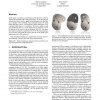Free Online Productivity Tools
i2Speak
i2Symbol
i2OCR
iTex2Img
iWeb2Print
iWeb2Shot
i2Type
iPdf2Split
iPdf2Merge
i2Bopomofo
i2Arabic
i2Style
i2Image
i2PDF
iLatex2Rtf
Sci2ools
VISUALIZATION
2002
IEEE
2002
IEEE
Compressing Polygon Mesh Geometry with Parallelogram Prediction
In this paper we present a generalization of the geometry coder by Touma and Gotsman [34] to polygon meshes. We let the polygon information dictate where to apply the parallelogram rule that they use to predict vertex positions. Since polygons tend to be fairly planar and fairly convex, it is beneficial to make predictions within a polygon rather than across polygons. This, for example, avoids poor predictions due to a crease angle between polygons. Up to 90 percent of the vertices can be predicted this way. Our strategy improves geometry compression by 10 to 40 percent depending on (a) how polygonal the mesh is and (b) on the quality (planarity/convexity) of the polygons. I.3.5 [Computer Graphics]: Computational Geometry and Object Modeling—surface, solid, and object representations;
| Added | 16 Jul 2010 |
| Updated | 16 Jul 2010 |
| Type | Conference |
| Year | 2002 |
| Where | VISUALIZATION |
| Authors | Martin Isenburg, Pierre Alliez |
Comments (0)

